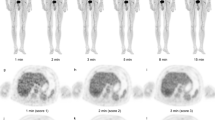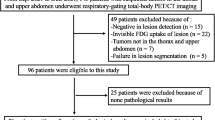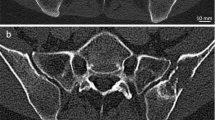Abstract
Objective
The aim of this study was to investigate the lesion detectability of a gamma camera based coincidence detector system (c-PET system) in comparison to the dedicated PET system (d-PET system), and thereby clarify the feasibility of the clinical application of this system and also describe any factors influencing the lesion detectability of the c-PET system.
Methods
We examined 74 patients including 19 with malignant lymphoma, 16 with lung cancer, 9 with primary malignant bone tumor, 7 with esophageal cancer, 6 with malignant melanoma, 3 with hepatocelluar carcinoma, 3 with primary unknown cancer, 2 with breast cancer, 2 with colon cancer, and 7 with others. d-PET images were obtained using ECAT EXACT HR+ at 60 min, followed by c-PET imaging using EC AM at 120 min after the injection of 185 MBq of FDG. Each image was reconstructed without any attenuation correction. In the image interpretation, the whole body was classified into 16 regions (5 superficial regions and 11 deep regions). The FDG accumulation of the lesions was evaluated by visual grading based on the consensus of three nuclear medicine physicians, and the findings were classified into three grades; (++), (+), and (-). The lesions were also classified into 3 groups according to their size: large group (≥ 2 cm), middle group ( 1 ≤ < 2 cm) and small group (< 1 cm).
Results
In 627 regions, the abnormal FDG uptake was detected in 109 regions by the d-PET system. Out of 109 regions, the c-PET system could detect the lesions in 91 regions and was false positive in 1 region. Therefore, the sensitivity, specificity, and accuracy of the c-PET system were 83.5%, 99.8% and 97.0%, respectively. Lesion detectability of the small group (54.5%) was significantly lower than that of the large group (97.9%) (p < 0.001) and that of the middle group (93.1%) (p < 0.001); however, the difference in lesion detectability between the large and middle groups was not significant. Neither the degree of FDG accumulation nor the location of the lesion markedly influenced the lesion detectability of the c-PET system. However, when we focused on the large and middle size lesions, the detectability of deep lesions tended to be lower than that of superficial lesions.
Conclusion
In conclusion, the lesion detectability of the c-PET system was inferior to that of the d-PET system, especially in the case of small lesions. Further examination is required to assess the clinical usefulness of the c-PET system.
Similar content being viewed by others
References
Delbeke D, Martin WH. Positron emission tomography imaging in oncology.Radiol Clin North Am 2001; 39:883–917.
Ak I, Blokland KAJ, Pauwels JKE, Stokkel MPM. The clinical value of18F-FDG detection with a dual-head coincidence camera: a review.Eur J Nucl Med 2001; 28:763–778.
Muehllehner G, Geagan M, Countryman P, Nellemann P. SPECT scanner with PET coincidence capability [abstract].J Nucl Med 1995; 36:70P.
Bailey D, Zito F, Gilardi M, Savi A, Fazio F, Jones T. Performance comparison of a state-of-the-art neuro-PET scanner and a dedicated neuro-PET scanner.Eur J Nucl Med 1994; 21:381–387.
Stokkel M, Terhaard C, Mertens I, Hordijk G, va RijkP. Fluorine-18-FDG detection of laryngeal cancer postradiotherapy using dual-head coincidence imaging.J Nucl Med 1998; 39:1385–1387.
Tatsumi M, Kitayama H, Sugahara H, Tokita N, Nakamura H, Kanakura Y, et al. Whole-body Hybrid PET with18F- FDG in the staging of non-Hodgkin’s lymphoma.J Nucl Med 2001; 42:601–608.
Weber W, Young C, Abdel-Dayem H, Sfakianakis G, Weir GJ, Swaney C, et al. Assessment of pulmonary lesons with18F-fluorodeoxyglucose positron imaging using coincidence mode gamma cameras.J Nucl Med 1999; 40:574–578.
Tatsumi M, Yutani K, Watanabe Y, Miyoshi S, Tomiyama N, Johkoh T, et al. Feasibility of fluorodeoxyglucose dual- head gamma camera coincidence imaging in the evaluation of lung cancer: comparison with FDG PET.J Nucl Med 1999; 40:566–573.
Shreve PD, Steventon RS, Deters EC, Kison PV, Gross MD, Wahl RL. Oncologic diagnosis with 2-[fluorine- 18]fluoro-2-deoxy-d-glucose imaging: dual-head coincidence gamma camera versus positron emission tomographic scanner.Radiology 1998; 207:431–437.
Coleman R. Camera-based PET: the best is yet to come.J Nucl Med 1997; 38:1796–1797.
Steinert H, Voellmy D, Trachsel C, Bicik I, Buck A, Huch R, et al. Planar coincidence scintigraphy and PET in staging malignant melanoma.J Nucl Med 1998; 39:1892–1897.
Delbeke D, Sandler MP. The role of hybrid cameras in oncology.Semin Nucl Med 2000; 30:268–280.
Boren EJ, Delbeke D, Ptton J, Sandler M. Comparison of FDG PET and positron coincidence detection imaging using a dual-head gamma camera with 5/8-inch Nal(Tl) crystals in patients with suspected body malignancies.Eur J Nucl Med 1999; 26:379–387.
Zimny M, Kaiser H, Cremerius U, Reinartz P, Schreckenberger M, Sabri M, et al. Dual-head gamma camera 2-[fluorine-18]-fluoro-2-deoxy-d-glucose positron emission tomography in oncological patients: effects of non-uniform attenuation correction on lesion detection.Eur J Nucl Med 1999; 26:818–823.
Kotzerke J, Guhlmann A, Moog F, Frickhofen N, Reske SN. Role of attenuation correction for fluorine-18 fluorodeoxyglucose positron emission tomography in the primary staging of malignant lymphoma.Eur J Nucl Med 1999; 26:31–38.
Bengel FM, Ziegler SI, Avril N, Weber W, Laubenbacher C, Schwaiger M. Whole-body positron emission tomography in clinical oncology: comparison between attenuation- corrected and uncorrected images.Eur J Nucl Med 1997; 24:1091–1098.
Farguhar TH, Llacer J, Hoh CK, Czernin J, Gambhir SS, Seltzer MA, et al. ROC and localization ROC analyses of lesion detection in whole-body FDG PET: effects of acquisition mode, attenuation correction and reconstruction algorithm.J Nucl Med 1999; 40:2043–2052.
Coleman R, Laymon C, Turkington T. FDG imaging of lung nodules: a phantom study comparing SPECT, camera-based PET and dedicated PET.Radiology 1999; 26:823- 828.
Weber WA, Neverve J, Sklarek J, Ziegler SI, Bartenstein P, King B, et al. Imaging of lung cancer with fluorine-18 fluorodeoxyglucose: comparison of a dual-head gamma camera in coincidence mode with a full-ring positron emission tomography system.Eur J Nucl Med 1999; 26:388- 395.
Koyama K, Okamura T, Kawabe J, Ozawa N, Higashiyama S, Ochi H, et al. The usefulness of18F-FDG PET images obtained 2 hours after intravenous injection in liver tumor.Ann Nucl Med 2002; 16:169–176.
Kubota K, Itoh M, Ozaki K, Ono S, Tashiro M, Yamaguchi K, et al. Advantage of delayed whole-body FDG-PET imaging for tumour detection.Eur J Nucl Med 2001 ; 28:696–703.
Paul AK, Tatsumi M, Yutani K, Fujino K, Hashikawa K, Nishimura T. Effects of iterative reconstruction on image contrast and lesion detection in gamma camera coincidence imaging in lung and breast cancers.Nucl Med Commun 2002; 23:103–110.
Author information
Authors and Affiliations
Corresponding author
Rights and permissions
About this article
Cite this article
Koga, H., Sasaki, M., Kuwabara, Y. et al. Lesion detectability of a gamma camera based coincidence system with FDG in patients with malignant tumors: A comparison with dedicated positron emission tomography. Ann Nucl Med 18, 131–136 (2004). https://doi.org/10.1007/BF02985103
Received:
Accepted:
Issue Date:
DOI: https://doi.org/10.1007/BF02985103




